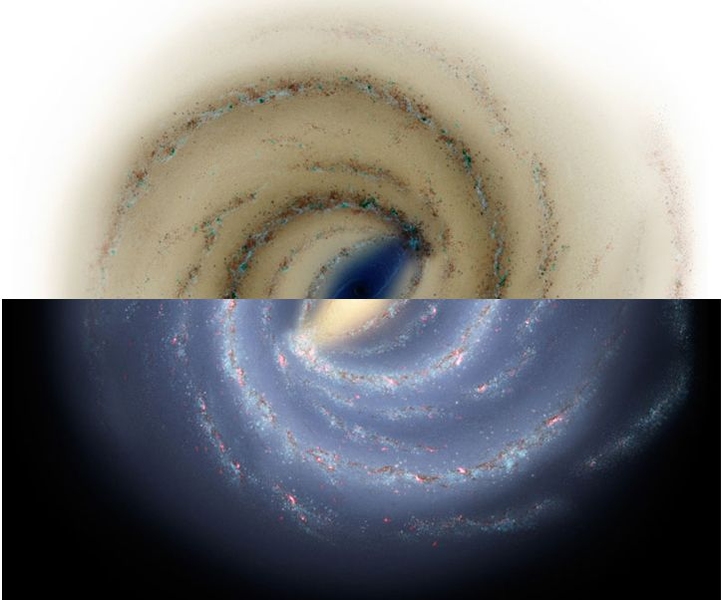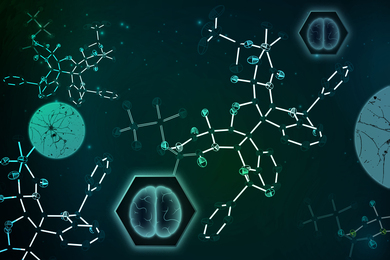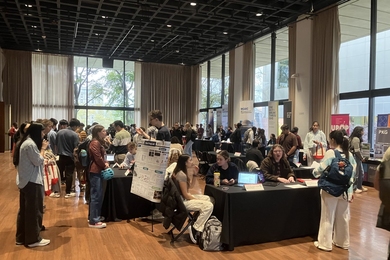Whether life exists elsewhere in our universe is a longstanding mystery. But for some scientists, there’s another interesting question: could there be life in a universe significantly different from our own?
A definitive answer is impossible, since we have no way of directly studying other universes. But cosmologists speculate that a multitude of other universes exist, each with its own laws of physics. Recently physicists at MIT have shown that in theory, alternate universes could be quite congenial to life, even if their physical laws are very different from our own.
In work recently featured in a cover story in Scientific American, MIT physics professor Robert Jaffe, former MIT postdoc, Alejandro Jenkins, and recent MIT graduate Itamar Kimchi showed that universes quite different from ours still have elements similar to carbon, hydrogen, and oxygen, and could therefore evolve life forms quite similar to us. Even when the masses of the elementary particles are dramatically altered, life may find a way.
“You could change them by significant amounts without eliminating the possibility of organic chemistry in the universe,” says Jenkins.
Pocket universes
Modern cosmology theory holds that our universe may be just one in a vast collection of universes known as the multiverse. MIT physicist Alan Guth has suggested that new universes (known as “pocket universes”) are constantly being created, but they cannot be seen from our universe.
In this view, “nature gets a lot of tries — the universe is an experiment that’s repeated over and over again, each time with slightly different physical laws, or even vastly different physical laws,” says Jaffe.
Some of these universes would collapse instants after forming; in others, the forces between particles would be so weak they could not give rise to atoms or molecules. However, if conditions were suitable, matter would coalesce into galaxies and planets, and if the right elements were present in those worlds, intelligent life could evolve.
Some physicists have theorized that only universes in which the laws of physics are “just so” could support life, and that if things were even a little bit different from our world, intelligent life would be impossible. In that case, our physical laws might be explained “anthropically,” meaning that they are as they are because if they were otherwise, no one would be around to notice them.
Jaffe and his collaborators felt that this proposed anthropic explanation should be subjected to more careful scrutiny, and decided to explore whether universes with different physical laws could support life.
This is a daunting question to answer in general, so as a start they decided to specialize to universes with nuclear and electromagnetic forces similar enough to ours that atoms exist. Although bizarre life forms might exist in universes different from ours, Jaffe and his collaborators decided to focus on life based on carbon chemistry. They defined as “congenial to life” those universes in which stable forms of hydrogen, carbon and oxygen would exist.
“If you don’t have a stable entity with the chemistry of hydrogen, you’re not going to have hydrocarbons, or complex carbohydrates, and you’re not going to have life,” says Jaffe. “The same goes for carbon and oxygen. Beyond those three we felt the rest is detail."
They set out to see what might happen to those elements if they altered the masses of elementary particles called quarks. There are six types of quarks, which are the building blocks of protons, neutrons and electrons. The MIT team focused on “up”, “down” and “strange” quarks, the most common and lightest quarks, which join together to form protons and neutrons and closely related particles called “hyperons.”
In our universe, the down quark is about twice as heavy as the up quark, resulting in neutrons that are 0.1 percent heavier than protons. Jaffe and his colleagues modeled one family of universes in which the down quark was lighter than the up quark, and protons were up to a percent heavier than neutrons. In this scenario, hydrogen would no longer be stable, but its slightly heavier isotopes deuterium or tritium could be. An isotope of carbon known as carbon-14 would also be stable, as would a form of oxygen, so the organic reactions necessary for life would be possible.
The team found a few other congenial universes, including a family where the up and strange quarks have roughly the same mass (in our universe, strange quarks are much heavier and can only be produced in high-energy collisions), while the down quark would be much lighter. In such a universe, atomic nuclei would be made of neutrons and a hyperon called the “sigma minus,” which would replace protons. They published their findings in the journal Physical Review D last year.
Fundamental forces
Jaffe and his collaborators focused on quarks because they know enough about quark interactions to predict what will happen when their masses change. However, “any attempt to address the problem in a broader context is going to be very difficult,” says Jaffe, because physicists are limited in their ability to predict the consequences of changing most other physical laws and constants.
A group of researchers at Lawrence Berkeley National Laboratory has done related studies examining whether congenial universes could arise even while lacking one of the four fundamental forces of our universe — the weak nuclear force, which enables the reactions that turn neutrons into protons, and vice versa. The researchers showed that tweaking the other three fundamental forces could compensate for the missing weak nuclear force and still allow stable elements to be formed.
That study and the MIT work are different from most other studies in this area in that they examined more than one constant. “Usually people vary one constant and look at the results, which is different than if you vary multiple constants,” says Mark Wise, professor of physics at Caltech, who was not involved in the research. Varying only one constant usually produces an inhospitable universe, which can lead to the erroneous conclusion that any other congenial universes are impossible.
One physical parameter that does appear to be extremely finely tuned is the cosmological constant — a measure of the pressure exerted by empty space, which causes the universe to expand or contract. When the constant is positive, space expands, when negative, the universe collapses on itself. In our universe, the cosmological constant is positive but very small — any larger value would cause the universe to expand too rapidly for galaxies to form. However, Wise and his colleagues have shown that it is theoretically possible that changes in primordial cosmological density perturbations could compensate at least for small changes to the value of the cosmological constant.
In the end, there is no way to know for sure what other universes are out there, or what life they may hold. But that will likely not stop physicists from exploring the possibilities, and in the process learning more about our own universe.
A definitive answer is impossible, since we have no way of directly studying other universes. But cosmologists speculate that a multitude of other universes exist, each with its own laws of physics. Recently physicists at MIT have shown that in theory, alternate universes could be quite congenial to life, even if their physical laws are very different from our own.
In work recently featured in a cover story in Scientific American, MIT physics professor Robert Jaffe, former MIT postdoc, Alejandro Jenkins, and recent MIT graduate Itamar Kimchi showed that universes quite different from ours still have elements similar to carbon, hydrogen, and oxygen, and could therefore evolve life forms quite similar to us. Even when the masses of the elementary particles are dramatically altered, life may find a way.
“You could change them by significant amounts without eliminating the possibility of organic chemistry in the universe,” says Jenkins.
Pocket universes
Modern cosmology theory holds that our universe may be just one in a vast collection of universes known as the multiverse. MIT physicist Alan Guth has suggested that new universes (known as “pocket universes”) are constantly being created, but they cannot be seen from our universe.
In this view, “nature gets a lot of tries — the universe is an experiment that’s repeated over and over again, each time with slightly different physical laws, or even vastly different physical laws,” says Jaffe.
Some of these universes would collapse instants after forming; in others, the forces between particles would be so weak they could not give rise to atoms or molecules. However, if conditions were suitable, matter would coalesce into galaxies and planets, and if the right elements were present in those worlds, intelligent life could evolve.
Some physicists have theorized that only universes in which the laws of physics are “just so” could support life, and that if things were even a little bit different from our world, intelligent life would be impossible. In that case, our physical laws might be explained “anthropically,” meaning that they are as they are because if they were otherwise, no one would be around to notice them.
Jaffe and his collaborators felt that this proposed anthropic explanation should be subjected to more careful scrutiny, and decided to explore whether universes with different physical laws could support life.
This is a daunting question to answer in general, so as a start they decided to specialize to universes with nuclear and electromagnetic forces similar enough to ours that atoms exist. Although bizarre life forms might exist in universes different from ours, Jaffe and his collaborators decided to focus on life based on carbon chemistry. They defined as “congenial to life” those universes in which stable forms of hydrogen, carbon and oxygen would exist.
“If you don’t have a stable entity with the chemistry of hydrogen, you’re not going to have hydrocarbons, or complex carbohydrates, and you’re not going to have life,” says Jaffe. “The same goes for carbon and oxygen. Beyond those three we felt the rest is detail."
They set out to see what might happen to those elements if they altered the masses of elementary particles called quarks. There are six types of quarks, which are the building blocks of protons, neutrons and electrons. The MIT team focused on “up”, “down” and “strange” quarks, the most common and lightest quarks, which join together to form protons and neutrons and closely related particles called “hyperons.”
In our universe, the down quark is about twice as heavy as the up quark, resulting in neutrons that are 0.1 percent heavier than protons. Jaffe and his colleagues modeled one family of universes in which the down quark was lighter than the up quark, and protons were up to a percent heavier than neutrons. In this scenario, hydrogen would no longer be stable, but its slightly heavier isotopes deuterium or tritium could be. An isotope of carbon known as carbon-14 would also be stable, as would a form of oxygen, so the organic reactions necessary for life would be possible.
The team found a few other congenial universes, including a family where the up and strange quarks have roughly the same mass (in our universe, strange quarks are much heavier and can only be produced in high-energy collisions), while the down quark would be much lighter. In such a universe, atomic nuclei would be made of neutrons and a hyperon called the “sigma minus,” which would replace protons. They published their findings in the journal Physical Review D last year.
Fundamental forces
Jaffe and his collaborators focused on quarks because they know enough about quark interactions to predict what will happen when their masses change. However, “any attempt to address the problem in a broader context is going to be very difficult,” says Jaffe, because physicists are limited in their ability to predict the consequences of changing most other physical laws and constants.
A group of researchers at Lawrence Berkeley National Laboratory has done related studies examining whether congenial universes could arise even while lacking one of the four fundamental forces of our universe — the weak nuclear force, which enables the reactions that turn neutrons into protons, and vice versa. The researchers showed that tweaking the other three fundamental forces could compensate for the missing weak nuclear force and still allow stable elements to be formed.
That study and the MIT work are different from most other studies in this area in that they examined more than one constant. “Usually people vary one constant and look at the results, which is different than if you vary multiple constants,” says Mark Wise, professor of physics at Caltech, who was not involved in the research. Varying only one constant usually produces an inhospitable universe, which can lead to the erroneous conclusion that any other congenial universes are impossible.
One physical parameter that does appear to be extremely finely tuned is the cosmological constant — a measure of the pressure exerted by empty space, which causes the universe to expand or contract. When the constant is positive, space expands, when negative, the universe collapses on itself. In our universe, the cosmological constant is positive but very small — any larger value would cause the universe to expand too rapidly for galaxies to form. However, Wise and his colleagues have shown that it is theoretically possible that changes in primordial cosmological density perturbations could compensate at least for small changes to the value of the cosmological constant.
In the end, there is no way to know for sure what other universes are out there, or what life they may hold. But that will likely not stop physicists from exploring the possibilities, and in the process learning more about our own universe.






